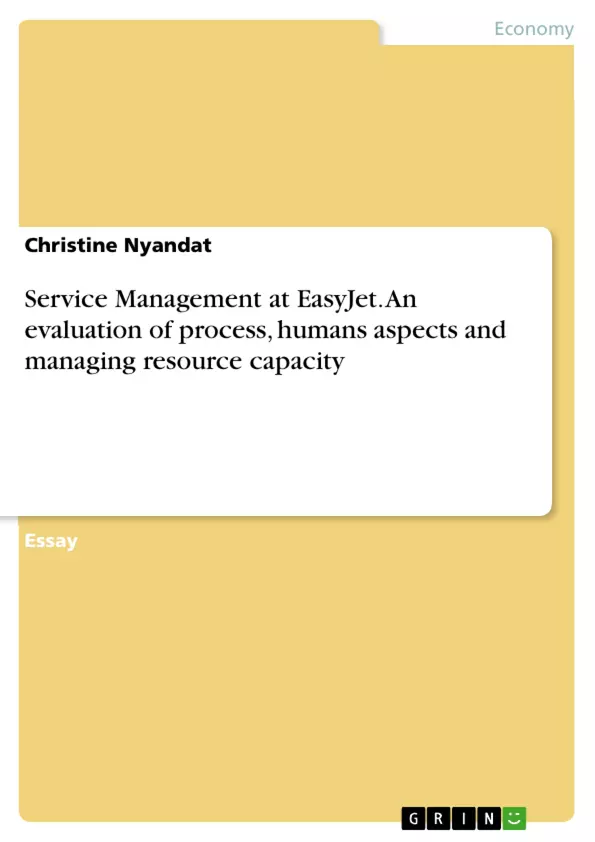This paper discusses the service management approaches at EasyJet with regard to process, humans aspects and managing resource capacity. Sir Stelios Haji-Ioannou founded EasyJet in 1995 with the vision of the creation of a customer-centric brand that would change the air travel concept. After the market leader Ryanair, EasyJet is the challenger in the European airline industry low-cost travel.
There are more than 500 routes and 129 airports that EasyJet serves in West Asia, North Africa, and Europe. As low-cost corporation EasyJet distinguished it from traditional airlines by its low-fares. EasyJet maintains low costs through elimination of unnecessary expenses and frills. Cost reduction is a strategy for reaching many clients as possible and EasyJet has adapted it as one of its service management approaches.
Inhaltsverzeichnis (Table of Contents)
- 1. Introduction
- 2. Process
- Purpose of processes
- Processes at EasyJet
- Booking Service
- Cabin and Onboard Services
- Quality Control
- Putting Flexibility ahead of Efficiency
- Delivering Good Service Online and Off
- Bringing all EasyJet Objectives into line
- Quality Assurance
- 3. Human Aspects
- Purpose of Human Aspects
- Human Aspects at EasyJet
- Limitation of EasyJet Human Aspect
- 4. Managing Resource Capacity
- Purpose of Managing Resource Capacity
- Managing Resource Capacity at EasyJet
- Limitation of Managing Resource Capacity at EasyJet
- 5. Conclusion
Zielsetzung und Themenschwerpunkte (Objectives and Key Themes)
This text aims to evaluate EasyJet's service management approaches, analyzing how the company manages processes, human aspects, and resource capacity to achieve its low-cost business model. It examines the effectiveness of these approaches in maintaining customer satisfaction and brand reputation.
- EasyJet's low-cost business model and its impact on service provision.
- The role of processes in delivering a consistent customer experience.
- The importance of human aspects in maintaining customer satisfaction.
- The challenges of managing resource capacity in a low-cost airline.
- The balance between efficiency and flexibility in service delivery.
Zusammenfassung der Kapitel (Chapter Summaries)
1. Introduction: This introductory chapter provides background information on EasyJet, its founding, and its position within the European low-cost airline industry. It highlights EasyJet's customer-centric vision and its strategy of cost reduction to achieve competitive pricing and attract a large customer base. The chapter sets the stage for a detailed analysis of the company's service management practices.
2. Process: This chapter delves into EasyJet's operational processes, focusing on various aspects of the customer journey. It explores the evolution of the booking process from telephone services to the predominantly online system, highlighting the impact of this shift on efficiency and customer convenience. The chapter also covers cabin and onboard services, emphasizing EasyJet's no-frills approach and its focus on cost-effectiveness. Quality control and flexibility are discussed, demonstrating EasyJet's efforts to balance efficiency with customer expectations. The chapter also examines the crucial alignment of business objectives and customer experience, emphasizing the importance of delivering a positive customer journey. EasyJet's approach to quality assurance and security, crucial aspects of their service, are also highlighted.
3. Human Aspects: (This section requires information from the original text which is not provided. A summary cannot be created without the text's content about "Human Aspects").
4. Managing Resource Capacity: (This section requires information from the original text which is not provided. A summary cannot be created without the text's content about "Managing Resource Capacity").
Schlüsselwörter (Keywords)
EasyJet, low-cost airline, service management, customer satisfaction, process efficiency, resource capacity, online booking, customer experience, brand reputation, cost reduction, quality control, security.
EasyJet Service Management: Frequently Asked Questions
What is the overall purpose of this text?
This text analyzes EasyJet's service management strategies, focusing on how the company manages its processes, human aspects, and resource capacity to support its low-cost business model. It evaluates the effectiveness of these strategies in maintaining customer satisfaction and brand reputation.
What topics are covered in the Table of Contents?
The text covers an introduction, a detailed look at EasyJet's processes (including booking services, cabin services, quality control, and flexibility), an examination of the human aspects of service management, an analysis of resource capacity management, and a conclusion. Each section explores EasyJet's approaches and their limitations.
What are the key themes explored in the text?
Key themes include EasyJet's low-cost business model and its impact on service provision, the role of processes in delivering a consistent customer experience, the importance of human aspects in maintaining customer satisfaction, the challenges of managing resource capacity in a low-cost airline, and the balance between efficiency and flexibility in service delivery.
What does the chapter on "Process" discuss?
The "Process" chapter examines EasyJet's operational processes, focusing on the customer journey. It details the evolution of the booking process (from phone to online), cabin and onboard services (highlighting the no-frills approach), quality control, the balance between efficiency and flexibility, aligning business objectives with customer experience, and quality assurance and security.
What information is missing from the provided text?
The summaries for chapters 3 ("Human Aspects") and 4 ("Managing Resource Capacity") are incomplete because the original text providing details on those topics was not included.
What are the key words associated with this text?
Key words include EasyJet, low-cost airline, service management, customer satisfaction, process efficiency, resource capacity, online booking, customer experience, brand reputation, cost reduction, quality control, and security.
What is the overall scope of this analysis?
The analysis aims to provide a comprehensive overview of EasyJet's service management, evaluating its strengths and weaknesses in achieving its business objectives within a competitive low-cost airline market. It uses a structured approach to examine different facets of the company's operations.
- Quote paper
- Christine Nyandat (Author), 2019, Service Management at EasyJet. An evaluation of process, humans aspects and managing resource capacity, Munich, GRIN Verlag, https://www.grin.com/document/502245



